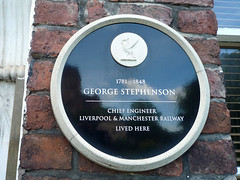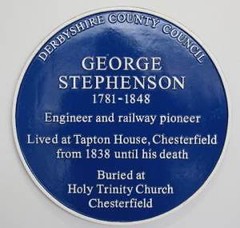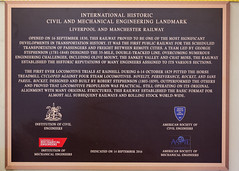George Stephenson
George Stephenson
(1781-1848)
Commemorated on 14 plaques
High Level Bridge. George Stephenson, first surveyed routes to Berwick in 1838. His son, Robert, 1803 - 1859, designed this bridge. Rail deck opened in 1849 - a major link in a London-Edinburgh railway. The road deck opened in February 1850.
High Level Bridge, Gateshead, United Kingdom where they surveyed routes
1781-1848 George Stephenson Chief Engineer Liverpool & Manchester Railway lived here
34 Upper Parliament Street, Liverpool, United Kingdom where they lived
Locomotion No 1 Locomotion was built to a design originated by George Stephenson, the first President of the Institution of Mechanical Engineers. On the opening day of the Stockton and Darlington Railway, 27 September 1825, he drove this engine, hauling the inaugural train, on the world's first steam-worked public railway.
Darlington Railway Museum, North Road Station, Darlington, United Kingdom where they designed (1824) and drove this engine, hauling the inaugural train on the opening day of the Stockton and Darlington Railway, the world's first steam-worked public railway (1825)
George Stephenson 1781-1848. Black Callerton. Stephenson worked at the nearby Dolly Pit from 1801-1802 when he married Frances Henderson (1769-1806), mother of Robert. In 1820 he married Elizabeth Hindmarsh a Black Callerton farmer's daughter.
West Farm, Black Callerton, Newcastle upon Tyne, United Kingdom where they worked near (1801-1802)
Stephenson's Railway Station The Liverpool - Manchester line of the station was opened in 1830 by the Duke of Wellington, famous for his victory at Waterloo
Vicarage Grove, Eccles, United Kingdom where they was
George Stephenson 1781-1848 engineer and railway pioneer lived at Tapton House, Chesterfield from 1838 until his death. Buried at Holy Trinity Church Chesterfield
Chesterfield Train Station, Chesterfield, United Kingdom where they lived near (1838-1848)
George Stephenson 1781-1848 Water Row, Newburn. From 1798 to 1801 George Stephenson was in charge of Robert Hawthorn's new pumping engine at Water Row Pit, where George's father, Robert was a fireman.
Newburn, Newcastle upon Tyne, United Kingdom where they was
George Stephenson joined his son, Robert, and others building the Birmingham to London railway, for dinner at the Dun Cow hotel, on 23rd December 1837. Robert Stephenson was the engineer for the project and the dinner marked the completion of the Kilsby Tunnel. This plaque was placed on 25th March 1982 by the institution of mechanical engineers of which George and Robert Stephenson respectively, were the first two presidents.
Dun Cow, Daventry Road, Dunchurch, United Kingdom where they dined (1837)
Tapton House late 18th century house. George Stephenson railway pioneer lived here 1838-1848
Tapton House, Chesterfield, United Kingdom where they lived (1837-1848)
International Historic Civil And Mechanical Engineering Landmark Liverpool and Manchester Railway Developments in transportation History. It was the first public railway for the scheduled transportation of passengers and freight between remote cities. A team led by George Stephenson (1781-1848) designed the 35-mile, double-tracked line. Overcoming numerous engineering challenges, including Olive Mount, The Sankey Valley and Chat Moss, the railway established the historic reputations of many engineers assigned to its various sections. The first ever locomotive trials at rainhill during 6-14 october 1829 pitted the horse treadmill cycloped against four steam locomotives. Novelty, Perseverance, Rocket, and Sans Pareil. Rocket, designed and built by Robert Stephenson (1803-1859), outperformed the others and proved that locomotive propulsion was practical. Still operating on its original alignment with many original structures, this railway established the basic format for almost all subsequent railways and rolling stock world-wide.
Station Road, Rainhill, United Kingdom where they was
Whitby to Pickering Railway Built between 1833 and 1835 by George Stephenson as part of the Whitby to Pickering Railway, the first carriages to run through this tunnel were horse-drawn and carried up to 10 passengers
Entrance to former railway tunnel, Grosmont, Whitby, United Kingdom where they was
This tunnel was built for the original horse drawn line It is a Grade Two Star listed structure The Tunnel, 130yds long, 14 feet high and ten feet wide, was designed by Frederick Swanwick, assistant to the engineer, George Stephenson and was only 22 years old. He was censured by the Directors for "wasting" money on this castellated north end. The line opened over its full length 26th May 1836. The company bought three 1st class coaches, Premier, Transit and Lady Hilda, from Beeston and Melling of Manchester. Engineer George Stephenson Assistant Frederick Swanwick
Grosmont Tunnel north portal, Grosmont, Whitby, United Kingdom where they was
Whitby to Pickering Railway. You are now on the original track opened in 1836, built by George Stephenson as a horse drawn tramway. it was bought by George Hudson, the "Railway King" in 1845 and improved to take steam locomotives. The line remained in regular use until 1865.
, Whitby, United Kingdom where they built (1835)
Grade I Stephenson's Bridge 1830 this bridge was constructed by George Stephenson to carry trains travelling between Manchester to Liverpool on the first passenger railway
Trinty Way, Manchester, United Kingdom where they was












